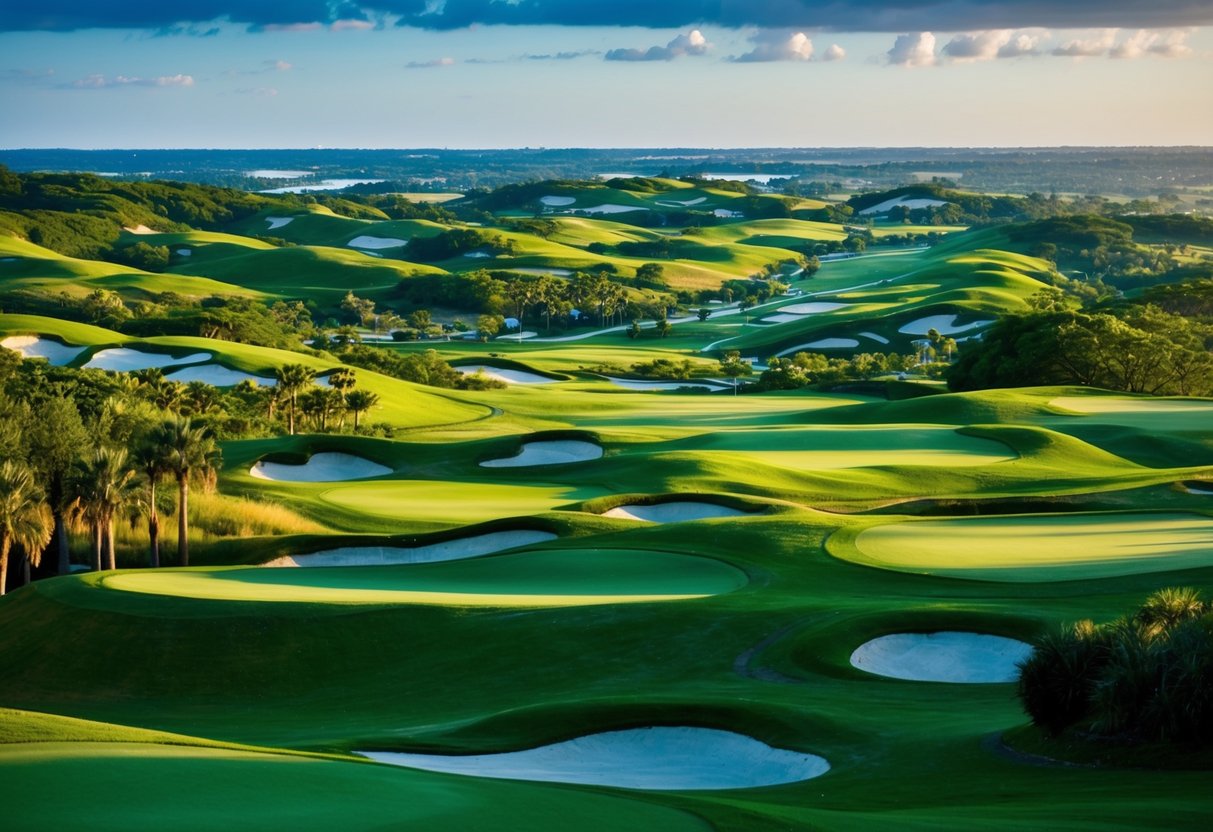Check out our golf rangefinders by Vovex to elevate your game!
Golf enthusiasts, have you ever wondered which state boasts the most golf courses? We're about to tee off on a journey across the United States to explore this very question. Prepare to be surprised by the answer and discover some fascinating facts about golf course distribution across the country.
Florida leads the pack with over 1,250 golf courses, making it the state with the most golf courses in the United States. This sunny paradise offers golfers an unparalleled variety of options, from championship courses to hidden gems. But Florida isn't alone in its golfing glory - several other states give it a run for its money.
We'll dive into the regional differences in golf course density, explore what makes certain states golf hotspots, and uncover some unexpected contenders. Whether you're planning your next golfing getaway or simply curious about the sport's landscape, this exploration of America's golf course geography is sure to pique your interest.
Key Takeaways
- Florida tops the list with over 1,250 golf courses
- Climate, tourism, and population influence golf course distribution
- Golf course design and accessibility vary widely across states
The State With the Most Golf Courses
Golf enthusiasts have plenty of options across the U.S., but a few states stand out for their abundance of courses. Let's explore the top contenders vying for the title of most golf-rich state.
Golfing in Florida
Florida boasts over 1,250 golf courses, making it the undisputed leader in sheer numbers. We've found that the Sunshine State's year-round warm climate is a major draw for golfers. Many world-class resorts and retirement communities here feature multiple courses.
The Jacksonville area alone has over 70 courses. Palm Beach County is another golfing hotspot, with more than 160 courses. We can't overlook iconic destinations like TPC Sawgrass, home of The Players Championship.
Florida's courses offer diverse landscapes, from coastal links to inland layouts dotted with palm trees and lakes. With so many options, it's no wonder Florida remains a top golfing destination.
Teeing Off in California
California comes in second with approximately 920 golf courses. The Golden State's varied terrain provides unique golfing experiences. We've seen how coastal courses like Pebble Beach and Torrey Pines attract golfers worldwide.
The Palm Springs area is a golfer's paradise, boasting over 120 courses in the Coachella Valley. Northern California offers its own gems, including Olympic Club and Harding Park in San Francisco.
California's courses range from desert layouts to mountain retreats. The state's diverse climate zones mean we can golf year-round in many areas. With numerous PGA Tour stops, California continues to be a major player in the golf world.
New York's Fairways
New York might surprise some, but it ranks third with about 850 golf courses. We've found that the Empire State offers a rich golfing history and diverse playing options.
Long Island is home to prestigious courses like Shinnecock Hills and Bethpage Black. The Westchester area north of New York City boasts many private clubs and public courses.
Upstate New York provides picturesque settings for golf, with courses nestled in the Adirondacks and Catskills. The state's varying seasons create unique golfing experiences throughout the year.
New York City itself offers several public courses, including Trump Golf Links at Ferry Point with stunning skyline views. The state's golf scene continues to thrive, attracting both locals and visitors.
Top Golf States by Region
Golf thrives across diverse landscapes in the United States. Each region boasts its own golfing hotspots, offering unique experiences for enthusiasts.
The Midwest's Green
We find golf paradise in the heartland. Michigan leads the pack with over 650 courses, many hugging the Great Lakes shorelines. Wisconsin isn't far behind, home to renowned destinations like Whistling Straits.
Ohio and Illinois also shine in the Midwest golf scene. Ohio's diverse terrain hosts nearly 600 courses, while Illinois boasts over 500, including the prestigious Medinah Country Club.
Minnesota's 10,000 lakes create a stunning backdrop for its 500+ courses. Indiana rounds out the Midwest's top golf states with picturesque layouts scattered across its rolling hills.
Golfing on the East Coast
New York takes the crown for East Coast golf with over 800 courses. From Bethpage Black to private clubs in the Hamptons, the Empire State offers variety for all skill levels.
Florida's year-round golfing climate makes it a top destination. With more than 1,000 courses, the Sunshine State attracts snowbirds and pros alike. The Players Championship at TPC Sawgrass is a highlight of the golf calendar.
Pennsylvania's rich golfing history shines through its 500+ courses. Oakmont Country Club, host to numerous U.S. Opens, stands out among the state's gems.
Massachusetts punches above its weight with nearly 400 courses. The Country Club in Brookline, one of the USGA's founding clubs, exemplifies the state's golfing heritage.
Swing Through the South
We can't discuss Southern golf without mentioning North Carolina. Home to Pinehurst Resort and over 500 courses, it's a must-visit for any golf enthusiast.
Georgia, birthplace of Bobby Jones and host of The Masters, boasts 400+ courses. Augusta National may be the most famous, but the state offers plenty of public options too.
South Carolina's golf scene thrives, particularly along the Grand Strand. Myrtle Beach alone claims over 100 courses, earning its nickname as the "Golf Capital of the World."
Texas goes big with golf, hosting more than 800 courses. From hill country layouts to coastal links, the Lone Star State offers diverse golfing experiences.
The West's Wonders
California leads the West with 900+ courses. Pebble Beach and Torrey Pines showcase the state's stunning coastal offerings, while desert courses thrive in Palm Springs.
Arizona's desert landscape provides a unique golfing backdrop. With 300+ courses, many in the Phoenix-Scottsdale area, it's a popular winter golf destination.
Colorado's mountain courses offer breathtaking views and challenging play. Over 200 courses dot the state, from Denver's suburbs to high-altitude resorts.
Hawaii may have fewer courses, but its tropical setting is unmatched. Oceanside layouts on Maui and the Big Island provide unforgettable golfing experiences.
Characteristics of Golf-Dense States
States with abundant golf courses share several key traits that make them ideal for the sport. These include favorable climates, prestigious tournaments, and significant economic contributions from golf-related activities.
Climate's Role on the Greens
We find that states with the most golf courses typically enjoy mild, golf-friendly weather for much of the year. Florida, California, and Arizona lead the pack, offering warm temperatures and ample sunshine. These conditions allow for year-round play, attracting both residents and tourists to the links.
In contrast, northern states like Minnesota and Michigan have shorter golf seasons due to harsh winters. However, they make up for it with lush, green courses during summer months. The varied landscapes in these states create diverse and challenging terrains for golfers.
Coastal states benefit from sea breezes, which can help maintain cooler temperatures during hot summer days. This pleasant climate encourages more frequent play and supports thriving golf communities.
Golf Events and Tournaments
States with numerous golf courses often host major professional and amateur tournaments. These events draw players and spectators from around the world, boosting local economies and raising the state's profile in the golfing community.
The Masters in Augusta, Georgia, is a prime example of a prestigious tournament that puts a state on the global golf map. Similarly, the U.S. Open rotates among top courses across the country, showcasing different states' golfing assets.
Many golf-dense states also feature multiple PGA Tour stops. These regular events provide consistent exposure and economic benefits throughout the year.
Economic Impact of Golf
We've observed that states with high concentrations of golf courses often see substantial economic benefits from the sport. Golf tourism is a major driver, with visitors spending money on accommodations, dining, and other local attractions.
The golf industry creates jobs in course maintenance, pro shops, and clubhouses. It also supports related businesses like equipment manufacturers and golf academies.
Property values near golf courses tend to be higher, contributing to increased tax revenues for local governments. These funds can be reinvested in community services and infrastructure improvements.
Golf-centric communities often develop around courses, featuring luxury homes and resorts. This further boosts the local economy and attracts high-income residents and visitors to the area.
Golf Accessibility and Public Courses
We love how golf is becoming more accessible across the United States. Public courses play a huge role in this trend. They offer affordable options for golf enthusiasts of all skill levels.
Many states are investing in public golf facilities. This opens up opportunities for more people to enjoy the sport. California, Florida, and New York lead the pack with numerous public courses.
Some key benefits of public courses:
- Lower green fees
- More relaxed atmosphere
- Easier tee time bookings
- Family-friendly environments
Public courses often feature golf programs for juniors and beginners. These initiatives help grow the sport and create new generations of golfers.
We're excited to see states prioritizing golf accessibility. It's not just about having the most courses, but making sure they're available to everyone. Public courses are the heart of this movement, bringing golf to communities nationwide.
The Evolution of Golf Course Design
Golf course design has come a long way since the sport's early days. We've seen remarkable changes in how courses are crafted and the principles that guide their creation.
In the beginning, courses were simple affairs. They followed the natural contours of the land with minimal alterations. Designers worked with what nature provided, creating holes that fit the existing landscape.
As golf grew in popularity, course design became more sophisticated. Architects began shaping the land to create more challenging and visually appealing layouts. This era saw the rise of strategic bunkering and water hazards.
The modern era of golf course design has brought new innovations:
- Environmental sustainability
- Advanced irrigation systems
- Computer-aided design tools
- Multi-purpose facilities
We've also witnessed a shift towards more player-friendly designs. Many new courses now offer multiple tee options to accommodate golfers of all skill levels.
Recent trends include minimalist designs that harken back to golf's roots. These courses emphasize natural beauty and strategic play over artificial obstacles.
Technology has played a significant role in shaping today's courses. GPS-guided maintenance equipment ensures precise care, while data analytics help optimize layouts for player enjoyment.
As we look to the future, we expect to see continued focus on sustainability and playability. Golf course design will likely evolve to meet changing player preferences and environmental considerations.
Golf Communities and Real Estate
Golf communities have become increasingly popular across the United States. These residential developments offer homeowners the chance to live near or on golf courses, providing easy access to their favorite sport.
We've seen a surge in demand for properties in these communities. Many feature luxurious amenities like clubhouses, swimming pools, and tennis courts alongside world-class golf facilities.
Florida leads the pack with numerous golf communities, thanks to its year-round warm climate. Arizona and South Carolina also boast significant numbers of these developments.
Home prices in golf communities often command a premium. The appeal of scenic views and proximity to courses drives up property values.
Here's a quick look at some top golf community states:
- Florida
- Arizona
- South Carolina
- California
- North Carolina
Investing in golf community real estate can be lucrative. Many buyers seek vacation homes or retirement properties in these areas.
We've noticed a trend of golf communities expanding their offerings. Some now include wellness centers, hiking trails, and other lifestyle amenities to attract a broader range of residents.
Driving Factors Behind Course Popularity
Golf's popularity in certain states stems from various factors. Climate plays a crucial role, with year-round warm weather allowing for extended playing seasons. This explains why southern states like Florida and California boast high course numbers.
Demographics also influence course abundance. Areas with higher concentrations of retirees and affluent residents tend to have more golf facilities. These populations often have more leisure time and disposable income to devote to the sport.
Tourism is another key driver. States that attract many visitors often feature numerous resort-style courses. These destinations cater to both local players and traveling golf enthusiasts.
The availability of suitable land impacts course development too. States with ample open spaces and varied terrain can more easily accommodate new golf projects.
Local culture and history contribute as well. Some regions have deep-rooted golfing traditions, fostering continued interest and investment in courses.
Economic factors play a part too. States with strong economies may see more golf course investments as part of real estate developments or corporate initiatives.
Lastly, government policies can affect course numbers. Some states offer incentives for golf course development, while others may have stricter land-use regulations.
Frequently Asked Questions
Golf course distribution across the US varies widely by state, city, and region. Let's explore some common questions about golf course numbers and concentrations nationwide.
What city in the US holds the record for the most golf courses?
Myrtle Beach, South Carolina, boasts the highest concentration of golf courses in the United States. With over 100 courses in the area, it's a true golfer's paradise.
How does the number of golf courses vary across the US states?
The number of golf courses differs significantly from state to state. Florida leads with over 1,000 courses, while Alaska has fewer than 25. Population, climate, and tourism play key roles in these variations.
Which region within the US is known as the golf capital?
We consider the Southeastern United States the golf capital of the country. States like Florida, South Carolina, and Georgia offer year-round golfing weather and numerous world-class courses.
What is the ratio of golf courses to population in the US states?
The ratio of golf courses to population varies widely. States like North Dakota and Vermont have high ratios, with about one course per 5,000 residents. More populous states typically have lower ratios.
How do California's golf courses count compare to other states?
California ranks second in total golf courses, behind only Florida. With over 900 courses, it offers diverse golfing experiences from coastal links to desert oases.
What are the top 10 states in terms of their number of golf courses?
The top 10 states for golf courses are:
- Florida
- California
- New York
- Michigan
- Texas
- Ohio
- Pennsylvania
- Illinois
- North Carolina
- Wisconsin






